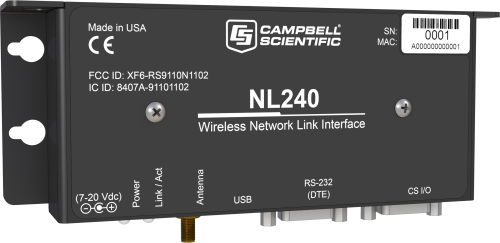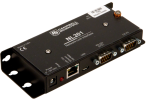This product is not available for new orders. We recommend ordering: NL241.

| Services Available | |
|---|---|
| Calibration | No |
概览
NL240 无线网络外设,可为我们的数据采集器和外设通过标准的802.11b/g/n网络,提供Wi-Fi 连接。NL240的功耗低,提供独特的功能强大的PakBus 网络功能,但可以轻松设置。NL240 支持直接访问CR800、CR1000和R3000 数据采集器的所有IP功能。
优势与特点
- Low power consumption
- Wi-Fi-to-CS I/O bridging provides direct access to Internet protocol capabilities of CR6, CR800, CR850, CR1000, or CR3000 dataloggers
- Powerful PakBus routing capabilities
- Serial server functionality for networking Campbell Scientific devices, as well as third-party devices
- Provides IP connectivity for communication with LoggerLink smartphone app and LoggerNet PC software
图像






相似产品
技术说明
NL240 能够利用数千个Wi-Fi 热点,可用于咖啡馆、大学、宾馆和机场。Wi-Fi 还能提供加密来保护通讯,以及使用全球的标准集,因此设备可在国际上使用。
NL240 是工业设备,比典型的Wi-Fi串口服务器更好。NL240支持与搭配使用我们的LoggerLink apps应用的iOS 或 Android设备进行Wi-Fi通讯。通过提供访问CR800、CR1000和CR3000数据采集器的所有IP功能,NL240 提供:
- 数据和事件的M2M通讯
- 通过TCP/IP进行的PakBus 通讯,用于远程的设置、控制和数据下载
- HTTP 和 FTP,用于寄送、下载和当地托管数据
- Email 客户端,用于数据和控制报文发送
- 支持ModBus、TCP/IP、DNP3和NTCIP ESS等工业协议
产品规格
| Compliance | CE compliant |
| Material | Aluminum case with black anodized finish |
| Configuration |
|
| CS I/O Port | SDC 7, 8, 10, or 11 (does not support ME) |
| RS-232 Port | DTE, DB9 Pin (Male) |
| USB Port | Micro-B |
| Operating Temperature Range |
|
| Power Connector | CS I/O Port, DC barrel connector (not powered over USB) |
| Powered Over | CS I/O or barrel plug |
| Supply Voltage | 7 to 20 Vdc |
| Connections/Routes Supported |
|
| Dimensions | 16 x 6.73 x 2.54 cm (6.3 x 2.65 x 1 in.) |
| Weight | 177 g (6.3 oz) |
Communication Rate |
|
| RS-232 Port | 1200 bps to 115.2 kbps |
| CS I/O Port | 9600 bps to 460.8 kbps |
WLAN |
|
| Antenna Connector | RPSMA |
| Technologies Supported | 802.11b/g/n, WPA, WPA2 /TKIP or AES, WEP, WEP(open), APIPA/AutoIP, IPv4, IPv6, ICMP/Ping, ICMPv6/Ping, TCP, DHCP Client, SLAAC, DNS Client, HTTPS Proxy, Telnet Server, TLS, PakBus, Modbus, TCP/IP |
| Topologies | Infrastructure and ad-hoc |
| Transmit Power | 7 to 17 dBm (5 to 50 mW) |
| Rx Sensitivity | -97 dBm (< 8% PER) |
| Frequency | 2.4 to 2.5 GHz (2.4 GHz ISM band) |
Power Consumption |
|
| Maximum | 950 mW |
| Typical (Always On) |
|
| Typical (Low Power Mode Enabled) |
|
| Sleep | 16 mW |
兼容性
Wi-Fi ad hoc networking is provided for the purpose of networking between NL240 interfaces. Ad hoc networking is supported by iOS, allowing an iOS device to connect to an NL240 that has created a network. Wi-Fi ad hoc networking is not supported natively by Android OS and is difficult to support on Windows 7 and greater.
Software
Our Device Configuration Utility must be version 2.03 or higher.
Data Logger Considerations
| Data Logger | Serial Server | PakBus Router | Bridge Mode* |
| CR300♣ |  |
 |
|
| CR200(X) Series |  |
 |
|
| CR800/CR850 |  |
 |
 |
| CR1000 |  |
 |
 |
| CR3000 |  |
 |
 |
| CR5000 |  |
||
| CR9000X |  |
||
| CR6 |  |
 |
 |
| CR1000X |  |
 |
 |
| CR510-PB |  |
 |
|
| CR10X-PB |  |
 |
|
| CR23X-PB |  |
 |
|
| Mixed-Array Data Loggers |
** |
Notes:
♣The CR300 connects to the NL240 using a 10873 serial cable that is not supplied with the CR300 or the NL240. The CR300-series dataloggers are not compatible with the bridge mode functionality in the NL240 interface.
* The data logger OS must be OS 25 or higher for bridge mode applications.
** It is possible to use an NL240 to connect to a mixed-array data logger (e.g., CR10, CR10X, CR23X, 21X, CR7) by using an SC32B between the data logger's CS I/O port and the NL240's RS-232 port.
下载
NL240 Drivers () 01-01-2014
Windows USB drivers for the NL240 are installed via the Device Configuration Utililty. In the Device Configuration Utility, click on the link "install the device driver for the NL240" in the main body of text for the NL240.
Note: Drivers must be installed before connecting the NL240 to your computer.
NL240 Firmware v.10.03 (671 KB) 04-09-2018
Current NL240 firmware. Requires the Device Configuration Utility and a USB micro cable.
Note: When updating to OS 10.03 from OS 6 or previous, settings will be reinitialized to factory defaults. When updating to OS 10.03 from OS 7, settings will be retained.
常见问题解答
NL240: 14
展开全部收起全部
-
No, it is not.
-
No. Antennas are ordered separately, allowing customers to choose the best antenna for their application and site.
-
Yes. The NL240 wireless network link was designed for this purpose.
-
If the NL240 is on a different network from the server running LoggerNet, either the station or LoggerNet needs to be able to initiate a connection to the other:
- The NL240/data logger needs an IP address that is accessible to the LoggerNet computer
OR
- LoggerNet needs an IP address that is accessible to the NL240/data logger.
-
The NL200-series of devices can be set to bridge the Ethernet or Wi-Fi interface and the CS I/O interface. All packets that come into the device via Ethernet or Wi-Fi will be transferred to the data logger over the CS I/O port. This enables the data logger to make all of its IP-related services available. Configuring an NL200-series device with bridge mode enabled is analogous to adding a native Ethernet or Wi-Fi port to the data logger. Bridge mode does not use PPP.
-
The NL201 and NL240 are available options.
-
Connect one data logger to the RS-232 port (6784) and the other data logger to the CS I/O port (6783). To access a data logger on the RS-232 port, use the IP address xxx.xxx.xxx.xxx:6784. To access a data logger on the CS I/O port, use xxx.xxx.xxx.xxx:6783. For setup instructions and configuration assistance, refer to the NL240 instruction manual, use the LoggerNet Network Planner tool, or contact Campbell Scientific.
-
The NL201 and NL240 are powered via the DC barrel connector and/or the CS I/O port. Sometimes, users who are using the network link
interface as a serial terminal server, PakBus router, or Modbus gateway want to connect their devices via the CS I/O port while
providing power only through the DC barrel connector and a 12 V source (such as a data logger SW12V output). In this scenario, a jumper
inside the NL201 or NL240 can be removed, preventing the interfaces from always being powered by the CS I/O connections. For more
information, refer to the instruction manual for the interface. -
It depends on the application, funds available for new hardware, and the quantity of data that will be collected. Viable options include the NL240, RF4xx spread-spectrum-series radios, RF32x UHF/VHF radios, and cellular modems.
